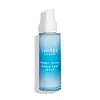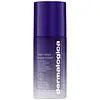What's inside
What's inside
 Key Ingredients
Key Ingredients

 Benefits
Benefits

 Concerns
Concerns

 Ingredients Side-by-side
Ingredients Side-by-side

Water
Skin ConditioningBetula Alba Juice
AstringentPropanediol
SolventCaprylic/Capric Triglyceride
MaskingGlycerin
HumectantPentylene Glycol
Skin ConditioningOlive Oil Polyglyceryl-6 Esters
EmollientVaccinium Myrtillus Fruit Juice
Skin ConditioningPhenoxyethanol
PreservativeXanthan Gum
EmulsifyingPEG-40 Hydrogenated Castor Oil
EmulsifyingSaccharide Isomerate
HumectantHydroxyacetophenone
AntioxidantSqualane
EmollientChondrus Crispus
MaskingSodium Hyaluronate
HumectantHydrolyzed Hyaluronic Acid
HumectantTrehalose
HumectantUrea
BufferingDisodium EDTA
Sodium Benzotriazolyl Butylphenol Sulfonate
UV AbsorberEthylhexylglycerin
Skin ConditioningAgar
MaskingSerine
MaskingSodium Hyaluronate Crosspolymer
HumectantCitric Acid
BufferingTris(Tetramethylhydroxypiperidinol)Citrate
StabilisingAlcohol
AntimicrobialSodium Hydroxide
BufferingCaprylyl Glycol
EmollientSodium Citrate
Buffering1,2-Hexanediol
Skin ConditioningAlgin
MaskingDisodium Phosphate
BufferingGlyceryl Polyacrylate
Pullulan
Ammonium Acryloyldimethyltaurate/Vp Copolymer
Gellan Gum
Potassium Phosphate
BufferingLinalool
PerfumingParfum
MaskingWater, Betula Alba Juice, Propanediol, Caprylic/Capric Triglyceride, Glycerin, Pentylene Glycol, Olive Oil Polyglyceryl-6 Esters, Vaccinium Myrtillus Fruit Juice, Phenoxyethanol, Xanthan Gum, PEG-40 Hydrogenated Castor Oil, Saccharide Isomerate, Hydroxyacetophenone, Squalane, Chondrus Crispus, Sodium Hyaluronate, Hydrolyzed Hyaluronic Acid, Trehalose, Urea, Disodium EDTA, Sodium Benzotriazolyl Butylphenol Sulfonate, Ethylhexylglycerin, Agar, Serine, Sodium Hyaluronate Crosspolymer, Citric Acid, Tris(Tetramethylhydroxypiperidinol)Citrate, Alcohol, Sodium Hydroxide, Caprylyl Glycol, Sodium Citrate, 1,2-Hexanediol, Algin, Disodium Phosphate, Glyceryl Polyacrylate, Pullulan, Ammonium Acryloyldimethyltaurate/Vp Copolymer, Gellan Gum, Potassium Phosphate, Linalool, Parfum
Water
Skin ConditioningSimmondsia Chinensis Seed Oil
EmollientGlycerin
HumectantNeopentyl Glycol Diheptanoate
EmollientSqualane
EmollientHydrogenated Ethylhexyl Olivate
EmollientPropanediol
SolventCaprylic/Capric Triglyceride
MaskingPentylene Glycol
Skin ConditioningCamellia Japonica Seed Oil
EmollientButylene Glycol
HumectantC12-15 Alkyl Benzoate
AntimicrobialSodium Hyaluronate
HumectantUbiquinone
AntioxidantGlycine Soja Oil
EmollientPEG-40 Hydrogenated Castor Oil
EmulsifyingHelianthus Annuus Seed Oil
EmollientCitrus Aurantium Bergamia Fruit Oil
MaskingCitrus Limon Peel Oil
MaskingRosmarinus Officinalis Leaf Extract
AntimicrobialViola Odorata Leaf Extract
MaskingCarthamus Tinctorius Seed Oil
MaskingTropaeolum Majus Flower/Leaf/Stem Extract
Skin ConditioningAstragalus Membranaceus Root Extract
EmollientSpilanthes Acmella Flower/Leaf/Stem Extract
AntimicrobialLavandula Spica Flower/Leaf/Stem Extract
Skin ConditioningLigustrum Lucidum Seed Extract
Skin ConditioningCitrus Aurantium Dulcis Oil
MaskingRosmarinus Officinalis Flower/Leaf/Stem Extract
MaskingSalvia Sclarea Extract
AntiseborrhoeicLitsea Cubeba Fruit Oil
MaskingMentha Piperita Flower/Leaf/Stem Extract
MaskingLuffa Cylindrica Root Extract
Skin ConditioningHydrogenated Olive Oil Unsaponifiables
EmollientTocopherol
AntioxidantPhospholipids
Skin ConditioningGlycogen
HumectantCaprylyl Glycol
EmollientGlycolipids
Skin ConditioningAcrylates/C10-30 Alkyl Acrylate Crosspolymer
Emulsion StabilisingGlycine Soja Sterols
EmollientDicaprylyl Ether
EmollientXanthan Gum
EmulsifyingC15-19 Alkane
SolventEthylhexylglycerin
Skin ConditioningPolysorbate 20
EmulsifyingTetrasodium Glutamate Diacetate
Phytic Acid
Lauryl Glucoside
CleansingSodium Hydroxide
BufferingSodium Acrylate/Sodium Acryloyldimethyl Taurate Copolymer
Emulsion StabilisingSodium Benzoate
MaskingWater, Simmondsia Chinensis Seed Oil, Glycerin, Neopentyl Glycol Diheptanoate, Squalane, Hydrogenated Ethylhexyl Olivate, Propanediol, Caprylic/Capric Triglyceride, Pentylene Glycol, Camellia Japonica Seed Oil, Butylene Glycol, C12-15 Alkyl Benzoate, Sodium Hyaluronate, Ubiquinone, Glycine Soja Oil, PEG-40 Hydrogenated Castor Oil, Helianthus Annuus Seed Oil, Citrus Aurantium Bergamia Fruit Oil, Citrus Limon Peel Oil, Rosmarinus Officinalis Leaf Extract, Viola Odorata Leaf Extract, Carthamus Tinctorius Seed Oil, Tropaeolum Majus Flower/Leaf/Stem Extract, Astragalus Membranaceus Root Extract, Spilanthes Acmella Flower/Leaf/Stem Extract, Lavandula Spica Flower/Leaf/Stem Extract, Ligustrum Lucidum Seed Extract, Citrus Aurantium Dulcis Oil, Rosmarinus Officinalis Flower/Leaf/Stem Extract, Salvia Sclarea Extract, Litsea Cubeba Fruit Oil, Mentha Piperita Flower/Leaf/Stem Extract, Luffa Cylindrica Root Extract, Hydrogenated Olive Oil Unsaponifiables, Tocopherol, Phospholipids, Glycogen, Caprylyl Glycol, Glycolipids, Acrylates/C10-30 Alkyl Acrylate Crosspolymer, Glycine Soja Sterols, Dicaprylyl Ether, Xanthan Gum, C15-19 Alkane, Ethylhexylglycerin, Polysorbate 20, Tetrasodium Glutamate Diacetate, Phytic Acid, Lauryl Glucoside, Sodium Hydroxide, Sodium Acrylate/Sodium Acryloyldimethyl Taurate Copolymer, Sodium Benzoate
 Reviews
Reviews

Ingredients Explained
These ingredients are found in both products.
Ingredients higher up in an ingredient list are typically present in a larger amount.
This ingredient is an emollient, solvent, and texture enhancer. It is considered a skin-softener by helping the skin prevent moisture loss.
It helps thicken a product's formula and makes it easier to spread by dissolving clumping compounds.
Caprylic Triglyceride is made by combining glycerin with coconut oil, forming a clear liquid.
While there is an assumption Caprylic Triglyceride can clog pores due to it being derived from coconut oil, there is no research supporting this.
Learn more about Caprylic/Capric TriglycerideCaprylyl Glycol is a humectant and emollient, meaning it attracts and preserves moisture.
It is a common ingredient in many products, especially those designed to hydrate skin. The primary benefits are retaining moisture, skin softening, and promoting a healthy skin barrier.
Though Caprylyl Glycol is an alcohol derived from fatty acids, it is not the kind that can dry out skin.
This ingredient is also used as a preservative to extend the life of products. It has slight antimicrobial properties.
Learn more about Caprylyl GlycolEthylhexylglycerin (we can't pronounce this either) is commonly used as a preservative and skin softener. It is derived from glyceryl.
You might see Ethylhexylglycerin often paired with other preservatives such as phenoxyethanol. Ethylhexylglycerin has been found to increase the effectiveness of these other preservatives.
Glycerin is already naturally found in your skin. It helps moisturize and protect your skin.
A study from 2016 found glycerin to be more effective as a humectant than AHAs and hyaluronic acid.
As a humectant, it helps the skin stay hydrated by pulling moisture to your skin. The low molecular weight of glycerin allows it to pull moisture into the deeper layers of your skin.
Hydrated skin improves your skin barrier; Your skin barrier helps protect against irritants and bacteria.
Glycerin has also been found to have antimicrobial and antiviral properties. Due to these properties, glycerin is often used in wound and burn treatments.
In cosmetics, glycerin is usually derived from plants such as soybean or palm. However, it can also be sourced from animals, such as tallow or animal fat.
This ingredient is organic, colorless, odorless, and non-toxic.
Glycerin is the name for this ingredient in American English. British English uses Glycerol/Glycerine.
Learn more about GlycerinPeg-40 Hydrogenated Castor Oil is derived from castor oil and polyethylene glycol (PEG). It is used as a emollient and emulsifier.
As an emulsifier, it helps prevent ingredients from separating. It also helps make the other ingredients more soluble; it is often used to solubilize fragrances. This increases spreadability and elongates shelf life in a product.
Emollients help soothe and soften the skin. They do this by creating a protective film on your skin. This barrier helps trap moisture and keeps your skin hydrated. Emollients may be effective at treating dry or itchy skin.
This ingredient may or may not be vegan, depending on the source.
Peg-40 Hydrogenated Castor Oil may not be fungal-acne safe. We recommend speaking with a professional if you have any questions or concerns.
Learn more about PEG-40 Hydrogenated Castor OilPentylene glycol is typically used within a product to thicken it. It also adds a smooth, soft, and moisturizing feel to the product. It is naturally found in plants such as sugar beets.
The hydrophilic trait of Pentylene Glycol makes it a humectant. As a humectant, Pentylene Glycol helps draw moisture from the air to your skin. This can help keep your skin hydrated.
This property also makes Pentylene Glycol a great texture enhancer. It can also help thicken or stabilize a product.
Pentylene Glycol also acts as a mild preservative and helps to keep a product microbe-free.
Some people may experience mild eye and skin irritation from Pentylene Glycol. We always recommend speaking with a professional about using this ingredient in your routine.
Pentylene Glycol has a low molecular weight and is part of the 1,2-glycol family.
Learn more about Pentylene GlycolPropanediol is an all-star ingredient. It softens, hydrates, and smooths the skin.
It’s often used to:
Propanediol is not likely to cause sensitivity and considered safe to use. It is derived from corn or petroleum with a clear color and no scent.
Learn more about PropanediolSodium Hyaluronate is hyaluronic acid's salt form. It is commonly derived from the sodium salt of hyaluronic acid.
Like hyaluronic acid, it is great at holding water and acts as a humectant. This makes it a great skin hydrating ingredient.
Sodium Hyaluronate is naturally occurring in our bodies and is mostly found in eye fluid and joints.
These are some other common types of Hyaluronic Acid:
Learn more about Sodium HyaluronateSodium Hydroxide is also known as lye or caustic soda. It is used to adjust the pH of products; many ingredients require a specific pH to be effective.
In small amounts, sodium hydroxide is considered safe to use. However, large amounts may cause chemical burns due to its high alkaline.
Your skin has a natural pH and acid mantle. This acid mantle helps prevent harmful bacteria from breaking through. The acid mantle also helps keep your skin hydrated.
"Alkaline" refers to a high pH level. A low pH level would be considered acidic.
Learn more about Sodium HydroxideSqualane is an emollient that helps the skin hold onto moisture. It's an oily liquid that occurs naturally in certain types of fish and plant oils.
Because squalane boosts hydration in the skin, it also comes with plenty of benefits: it is an antioxidant and can help fight free radicals and skin damage. Squalane is also found to have a detoxifying effect when applied.
Squalane comes from squalene, which occurs naturally within the sebum of our skin. It is one of the oils our skin produces to keep itself hydrated. Squalane is the hydrogenated version of squalene and has a longer shelf life.
Research shows that squalane is non-irritating (even at 100% concentration).
In general, it's a fantastic ingredient. It does a great job at hydrating the skin, and it's suitable for those with sensitive skin.
The source of squalane may impact malassezia / fungal acne. This is because olive oil derived squalane can contain impurities such as fatty acids and plant waxes. Sugarcane derived squalane is recommended for anyone with malassezia concerns.
Is squalane vegan?
This depends on the source. Squalane can be derived from both plants and animals. Most squalane used in skincare comes from plants.
Please note: the source of squalane is only known if disclosed by the brand. We recommend reaching out to the brand if you have any questions about their squalane.
Read more about squalene with an "e".
Is squalane an oil?
Squalane is often called an oil, but it’s technically not; it’s a hydrocarbon, meaning it’s only made of carbon and hydrogen, unlike true oils which are triglycerides made of fatty acids and glycerol.
The term “oil-free” isn’t regulated, so companies can define it however they want. Some exclude all oils, while others just avoid mineral oil or comedogenic oils.
While some people avoid oils thinking they cause breakouts, the right kind of oil (or oil-like ingredient like squalane) can actually help balance and hydrate your skin. It’s worth testing out simple oils or squalane to see what works best for your skin.
Learn more about SqualaneWater. It's the most common cosmetic ingredient of all. You'll usually see it at the top of ingredient lists, meaning that it makes up the largest part of the product.
So why is it so popular? Water most often acts as a solvent - this means that it helps dissolve other ingredients into the formulation.
You'll also recognize water as that liquid we all need to stay alive. If you see this, drink a glass of water. Stay hydrated!
Learn more about WaterXanthan gum is used as a stabilizer and thickener within cosmetic products. It helps give products a sticky, thick feeling - preventing them from being too runny.
On the technical side of things, xanthan gum is a polysaccharide - a combination consisting of multiple sugar molecules bonded together.
Xanthan gum is a pretty common and great ingredient. It is a natural, non-toxic, non-irritating ingredient that is also commonly used in food products.
Learn more about Xanthan Gum